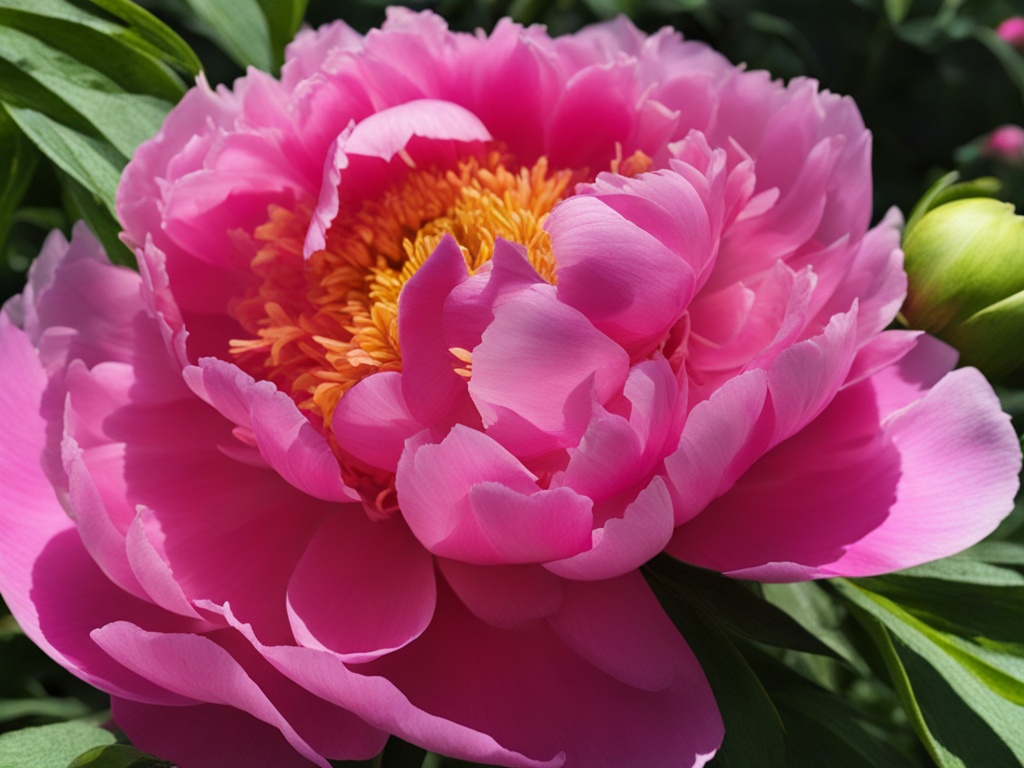I’ve always loved the beauty of peonies. These flowers are known for their big, fluffy blooms in many colors. They make any garden look special. Taking care of peonies is a bit of work, but it’s worth it for their beautiful flowers every year.
To keep your peonies thriving, you need to know how to plant, water, feed, and prune them. This guide will give you easy tips to care for your peonies. Follow these steps to enjoy their lovely flowers in your garden.
Introduction to Peony Care
Peonies are a stunning group of plants, with over 6,500 types. They come in three main types: herbaceous, tree, and Itoh. Knowing what each type needs is key to keeping them healthy and blooming well.
Types of Peonies
Herbaceous peonies are the most common. They grow up to 3 feet tall and do well in USDA Hardiness Zones 3-8. Tree peonies are taller shrubs that bloom early (around April) in Zones 4-9, reaching 3-7 feet tall.
Itoh peonies are a mix of herbaceous and tree peonies. They have lots of flowers on strong stems and do best in Zones 4-9.
Importance of Proper Care
Peonies need the right conditions to grow well. They need sunlight, water, and nutrients. Also, the right planting and pruning are crucial.
By knowing what each peony type needs, gardeners can create the perfect spot for them. This helps these plants bloom beautifully every year.
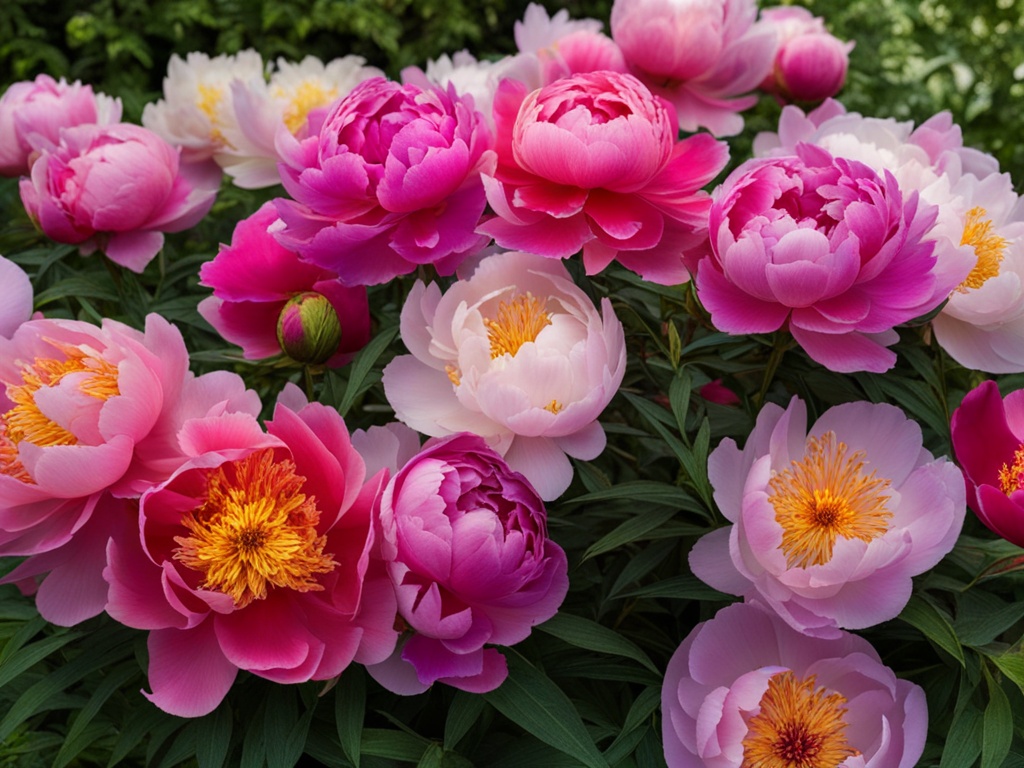
Peonies range from the sweet-smelling Festiva Maxima to the bright and heat-resistant Coral Charm. Learning how to care for peonies lets you enjoy their beauty in your garden.
Planting Peonies
Planting peonies at the right time is crucial. They do best when planted in early fall. This way, they bloom beautifully the next year. Make sure they get at least six hours of sunlight and have soil that drains well.
Peonies come as root divisions, with three to four “eyes” each. These should be healthy and free from rot or damage. Dig holes 12 to 18 inches deep and 18 inches wide, about 3 to 4 feet apart.
Before adding the root division, mix in some 10-10-10 fertilizer. Fill the hole halfway with this enriched soil. Place the root division so the eyes face up, with the eyes 2 inches below the soil. Then, fill the hole back up and water well.
Planting peonies in the ground or a container requires the right conditions for them to grow. Follow these tips to enjoy their beautiful blooms.

Peonies are tough plants that grow in Zones 2 to 8. With proper care, you can have these lovely flowers for many years.
Sunlight and Water Requirements
Peonies love the sun and need at least six to eight hours of direct peony sunlight needs every day. They also do well in soil that drains well and has a slightly acidic to neutral pH. This is key for their peony growing conditions.
In their first fall and spring, peonies need regular water to grow strong roots. But after they settle, they only need water when the soil feels dry. These plants also need a good winter freeze to store energy and prepare for spring. So, they don’t do well in warm places like Southern California, Florida, and some southern states.
| Sunlight Requirement | Watering Needs |
|---|---|
| At least 6-8 hours of direct sunlight daily | Regular watering during first fall and spring, then water when soil is dry |
With proper peony watering requirements and peony soil drainage, peonies will flourish. They’ll give you beautiful, long-lasting flowers every year.
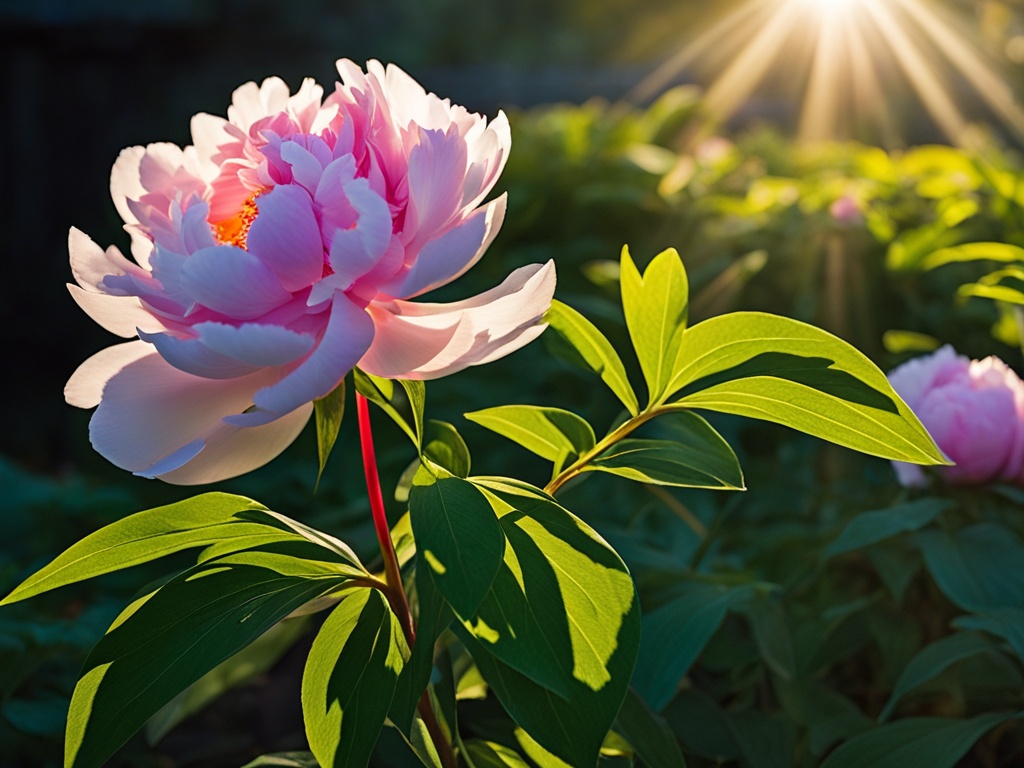
Fertilizing and Pruning
Fertilizing Peonies
Peonies need a lot of food to grow well. Peony fertilizer is key, and when you give it matters. Feed your peonies with a balanced fertilizer in early spring when they’re about 12-16 inches tall. Then, give them another dose right after the flowers fade.
This double dose helps them grow strong and bloom beautifully. Choose a fertilizer with a balanced NPK ratio, like 3-4-5 or 3-5-5. For herbaceous peonies, use about ¼ cup of peony fertilizer per plant. Tree peonies might need up to ½ cup.
But don’t overdo it, as too much fertilizer can harm your plants. Slow-release fertilizers are great because they feed your peonies steadily over time. Spread this type of fertilizer around the plant’s base, about 3-4 inches away from the stems. Then, mix it into the soil with a tool.
Bone meal is also good for peonies, giving them phosphorus for strong roots and flowers. Just check your soil’s phosphorus levels before adding bone meal.
Don’t put mulch right on top of peonies, as it can cause crown rot. Instead, lay a thin layer of mulch a few inches away from the stems. This keeps the soil moist and cool.
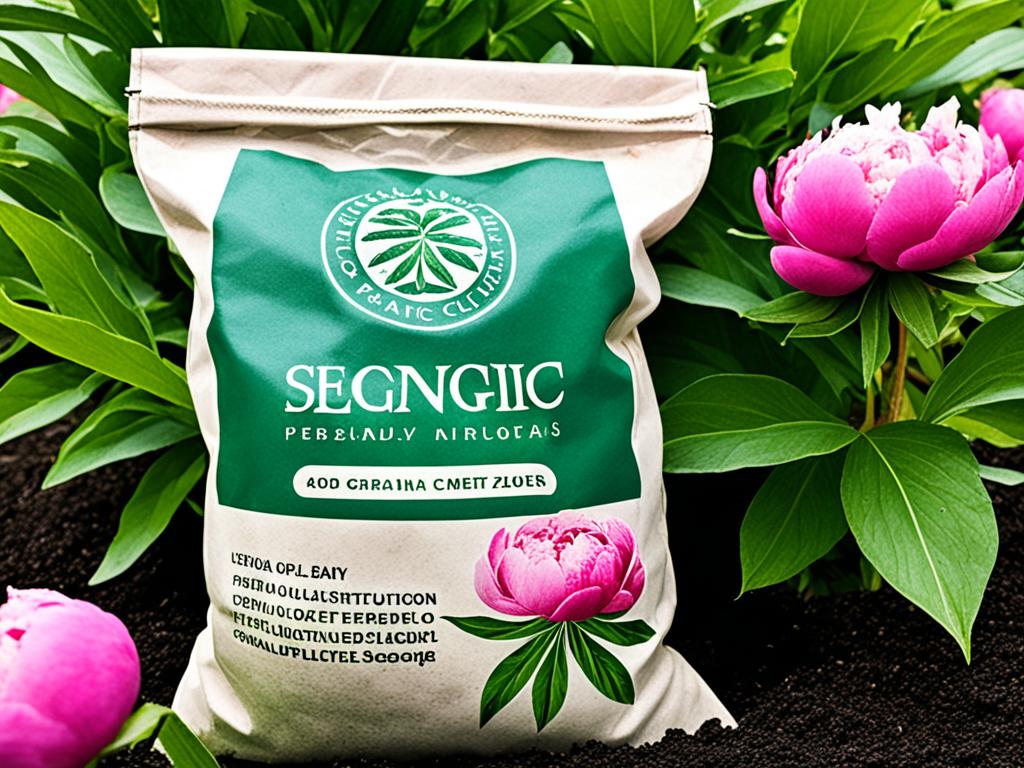
How to Take Care of a Peony?
Peonies are known for their beautiful, long-lasting flowers and toughness. With a little care, these perennials can live for over 100 years. Knowing how to care for peonies helps keep them healthy and blooming year after year.
Spring Care
When spring gets warmer, it’s time to help your peonies. Start by adding a thin layer of compost around the plants. This gives them nutrients for growth. Also, use a slow-release fertilizer to feed your peonies, helping them grow strong and bloom well.
Summer Care
In summer, it’s important to prune your peonies regularly. This keeps their shape and controls insects. Don’t cut the stems with the big, round bulbs, though. These bulbs are what produce the beautiful flowers next year.
Fall and Winter Care
After the first frost in fall, cut your peony bushes down to the ground. This encourages new growth in spring. Fall is also a good time to move or spread your peonies. Peonies don’t need much care in winter, as they can handle the cold well.
By following this peony care timeline, your peonies will thrive and keep blooming beautifully for many years.
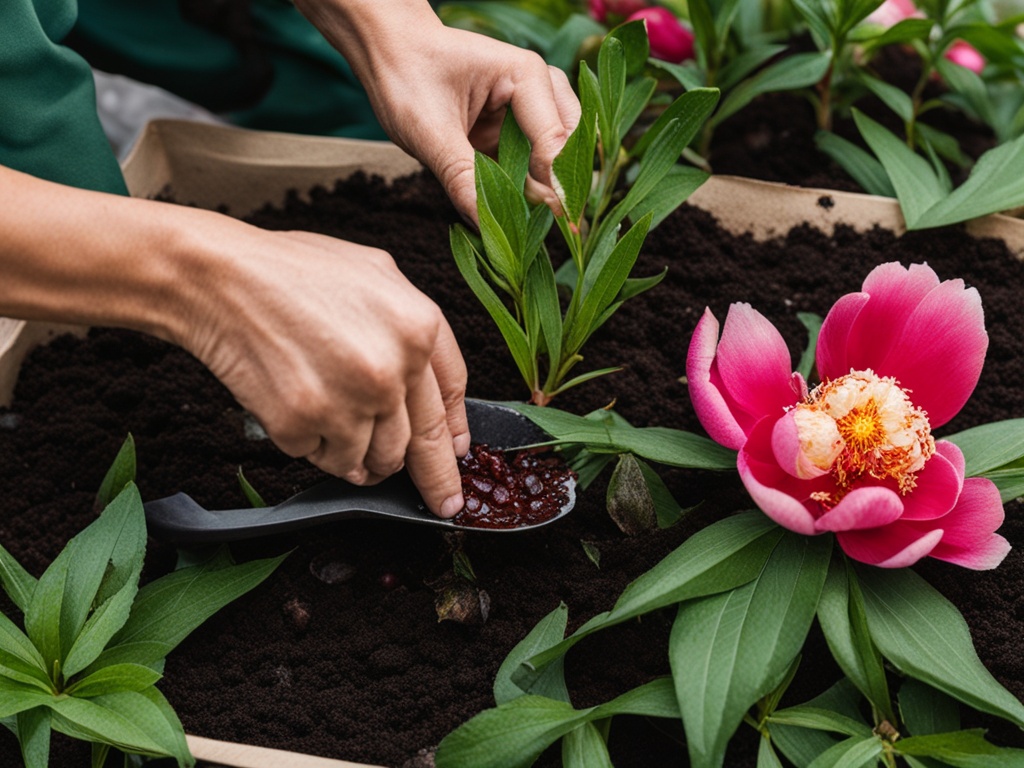
| Peony Care Task | Timing |
|---|---|
| Add compost and fertilize | Early spring |
| Prune and deadhead | Summer |
| Cut back to soil level | After first fall frost |
| Transplant or propagate | Fall |
Transplanting Peonies
Transplanting peonies is a careful process. With the right steps, you can move these beautiful flowers without harming their roots. Peonies can live over a century, but moving them can slow their growth by up to three years.
The best time to move peonies is in the fall. This is when they die back and prepare for spring. In the North, mid-August is the best month. For Southern gardeners, early November works well.
When moving peonies, dig around the plant carefully. Make sure the root ball is at least 18 inches wide. This helps prevent root damage and boosts the transplant’s success. The hole for the new plant should be twice as wide as the roots and deep enough for the plant’s crown to sit 1 inch below the soil.
- Prepare the new spot by adding compost to the soil. Mix it with the native soil in a 50/50 ratio for good drainage.
- Lift the peony plant carefully, keeping the roots together.
- Put the peony in the new hole, making sure the buds are 2 inches below the soil.
- Water the plant well and cover it with organic mulch to keep moisture in and weeds out.
With the right care, your peonies will come back strong and show off their beautiful flowers. Remember, it might take two to three years for them to bloom fully after transplanting.
“Transplanting peonies is a delicate dance, but the payoff is worth it. With the right timing and techniques, you can successfully relocate these beautiful flowers and enjoy their vibrant blooms for decades to come.”
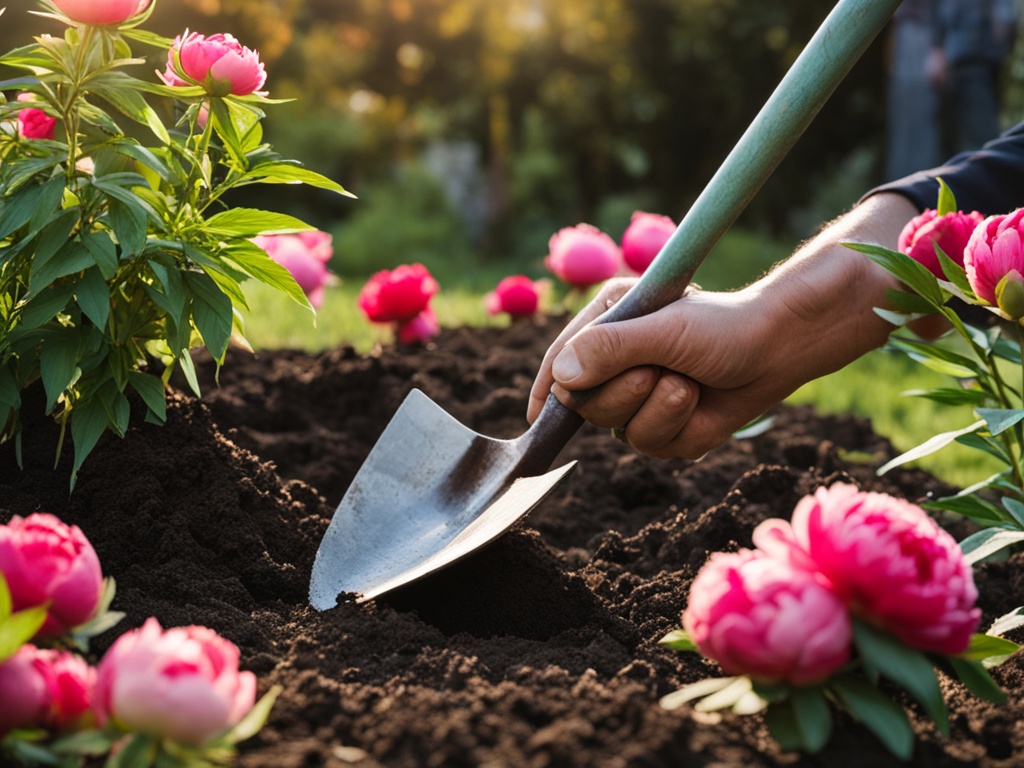
Troubleshooting Common Issues
“A happy peony is a blooming peony.” But, these lovely flowers can face some common problems. These issues can affect their growth and how much they bloom. By fixing these problems early, you can help your peonies flourish for many years.
Lack of Sunlight and Sunburn
Peonies need at least 6 hours of direct sunlight each day to grow well and bloom. If they don’t get enough sun, they might grow long and produce fewer flowers. On the other hand, too much sun can burn their leaves. You might need to move the peony to a sunnier spot or give it some shade during the hottest part of the day.
Non-Blooming Peonies
If your peony has lots of leaves but no flowers, it might be planted too deep. Peonies should be planted so the eyes (buds) are only 1-2 inches below the soil. Dig up the plant and replant it correctly to help it bloom.
Peony Diseases and Pests
- Powdery mildew – This fungal disease makes leaves and stems look white and powdery. Use neem oil or baking soda sprays and make sure air moves well around the plants to fight it.
- Botrytis blight – Also called gray mold, this disease can make peony stems wilt and rot suddenly. Keep the area well-drained, well-aired, and clean up any fallen leaves to prevent it.
- Hoplia beetles – These small beetles eat peony flowers in the spring, causing damage and odd shapes.
By keeping an eye out and fixing problems quickly, you can keep your peonies healthy and blooming every year.
Conclusion
Peonies are a favorite perennial that can bring beautiful, full blooms every year with the right care. By knowing what different peony types need, you can plant them in the best spots. Make sure they get enough sunlight and water, and feed and prune them at the right times.
Common issues can also be fixed to keep your peonies looking great. With the easy tips in this guide, you can take great care of your peonies. This will help you have a garden full of color and life.
Peonies come in many types and are important in many cultures. They are a joy to grow and admire. If you’re new or experienced with peony care, following the best practices will make your garden look amazing.
With a bit of effort and the right methods, you can grow peonies that make your garden beautiful for years. These flowers are long-lasting and add beauty to your outdoor space.
This guide gives you all you need to know about peony care. By following these tips, you’ll have a garden full of stunning peonies. Let these beautiful flowers be the highlight of your garden oasis.
FAQ
What are the different types of peonies?
There are over 6,500 types of peonies. They are divided into three main groups: herbaceous, tree, and Itoh. Herbaceous peonies are the most common and grow on stems. Tree peonies are stemmed shrubs. Itoh peonies are a mix of herbaceous and tree varieties.
When is the best time to plant peonies?
The best time to plant peonies is early fall. Planting them in spring may delay blooms until the next year or later.
How much sunlight do peonies need?
Peonies need at least six hours of full sunlight each day. This helps them grow and produce lots of big, healthy flowers.
How often should peonies be watered?
In their first fall and spring, peonies need regular watering. Once they’re established, water them only when the soil feels dry.
When should peonies be pruned?
Prune peonies in late fall or early spring. Cut them back to ground level before new growth starts.
How often should peonies be fertilized?
After they bloom, feed peonies with a mix of compost and a bit of 10-10-10 fertilizer every year.
Can peonies be transplanted?
Transplanting peonies is hard because they have deep roots that connect strongly with the soil. Transplanting them can make them take a long time to recover and may delay blooms for up to three years.
What are some common issues that peonies may encounter?
Peonies might face problems like not getting enough sunlight, getting too much sunlight, or being planted too deep. They can also get powdery mildew. This can be treated with neem oil or a baking soda spray and by improving air flow around the plants.
